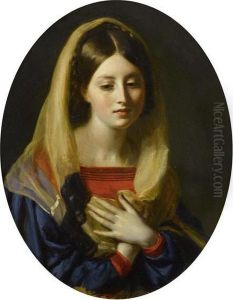Jeanne-Francoise-Etiennette Dansse-Romilly Paintings
Jeanne-Françoise-Étiennette Dansse, also known as Madame Romilly after her marriage, was a French painter active during the late 18th and early 19th centuries. Born in 1749, she was part of an era that witnessed the tumult of the French Revolution and the Napoleonic Wars.
Not much is known about her early life and training, but she was likely to have received an education in the arts that was typical of women from her social class at the time. Women artists often faced significant obstacles in pursuing their careers; they were excluded from formal academies and had limited opportunities to study the human figure, which was essential for historical painting. Despite these barriers, some women managed to achieve recognition for their work.
Madame Romilly specialized in portraiture, a genre more accessible to women artists, as it did not require the academic training denied to them. Her work was known for its delicate and precise style, capturing the likeness and character of her subjects. She participated in the Paris Salons, which were the official art exhibitions of the Académie des Beaux-Arts in Paris. This was a significant achievement, as the Salons were central to the art world and the careers of artists in France.
During the French Revolution, the art world underwent significant changes, as did the patronage system. Many artists, including women, found new opportunities to engage with different themes and subjects, such as portraying the heroes of the Revolution. While Jeanne-Françoise-Étiennette Dansse-Romilly’s work from this period is not well-documented, it is likely that she, like many of her contemporaries, navigated the shifting political and social landscapes in her artistic practice.
Madame Romilly continued to paint into the early 19th century. Her later life coincided with the rise of Neoclassicism, which was characterized by a return to classical simplicity and grandeur. It is not clear how much her work was influenced by this movement, as the details of her artistic production are scant.
Jeanne-Françoise-Étiennette Dansse-Romilly passed away in 1822. While her legacy is not as well-known as some of her male contemporaries, her contributions as a woman artist in a male-dominated field during a time of great social upheaval are significant. Her life and work reflect the challenges and achievements of women artists in the late 18th and early 19th centuries.
